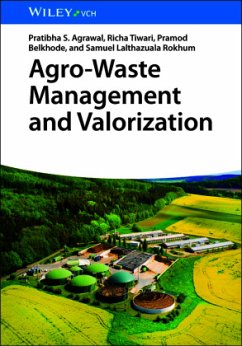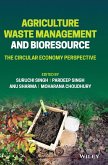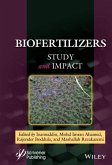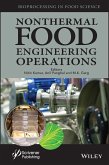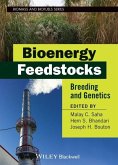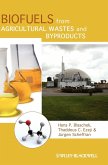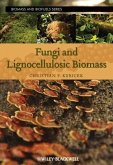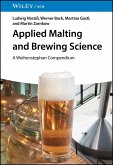Versandkostenfrei innerhalb Deutschlands
111,99 €
inkl. MwSt.
Versandkostenfrei*
Erscheint vorauss. Januar 2026
Melden Sie sich
hier
hier
für den Produktalarm an, um über die Verfügbarkeit des Produkts informiert zu werden.
oder sofort lesen als eBook

56 °P sammeln
- Gebundenes Buch
Explores the multifaceted approaches to sustainable waste management and energy generation.
Andere Kunden interessierten sich auch für
![Agriculture Waste Management and Bioresource Agriculture Waste Management and Bioresource]() Agriculture Waste Management and Bioresource189,99 €
Agriculture Waste Management and Bioresource189,99 €![Biofertilizers Biofertilizers]() I InamuddinBiofertilizers216,99 €
I InamuddinBiofertilizers216,99 €![Nonthermal Food Engineering Operations Nonthermal Food Engineering Operations]() Nonthermal Food Engineering OperationsNonthermal Food Engineering Operations219,99 €
Nonthermal Food Engineering OperationsNonthermal Food Engineering Operations219,99 €![Bioenergy Feedstocks Bioenergy Feedstocks]() Malay SahaBioenergy Feedstocks211,99 €
Malay SahaBioenergy Feedstocks211,99 €![Biofuels from Agricultural Wastes and Byproducts Biofuels from Agricultural Wastes and Byproducts]() Hans P. BlaschekBiofuels from Agricultural Wastes and Byproducts238,99 €
Hans P. BlaschekBiofuels from Agricultural Wastes and Byproducts238,99 €![Fungi and Lignocellulosic Biomass Fungi and Lignocellulosic Biomass]() Fungi and Lignocellulosic Biomass218,99 €
Fungi and Lignocellulosic Biomass218,99 €![Applied Malting and Brewing Science Applied Malting and Brewing Science]() Ludwig NarzißApplied Malting and Brewing Science77,99 €
Ludwig NarzißApplied Malting and Brewing Science77,99 €-
-
-
Explores the multifaceted approaches to sustainable waste management and energy generation.
Produktdetails
- Produktdetails
- Verlag: Wiley-VCH
- Artikelnr. des Verlages: 1135575 000
- 1. Auflage
- Seitenzahl: 288
- Erscheinungstermin: Januar 2026
- Englisch
- Abmessung: 244mm x 170mm
- ISBN-13: 9783527355754
- Artikelnr.: 75281731
- Herstellerkennzeichnung Die Herstellerinformationen sind derzeit nicht verfügbar.
- Verlag: Wiley-VCH
- Artikelnr. des Verlages: 1135575 000
- 1. Auflage
- Seitenzahl: 288
- Erscheinungstermin: Januar 2026
- Englisch
- Abmessung: 244mm x 170mm
- ISBN-13: 9783527355754
- Artikelnr.: 75281731
- Herstellerkennzeichnung Die Herstellerinformationen sind derzeit nicht verfügbar.
Pratibha S Agrawal is a Ph.D. supervisor at Laxminarayan Innovation Technological University. With 16 years of teaching and research experience, she is a recognized authority in the field of applied chemistry.
Richa Tiwari is currently pursuing Ph.D. Laxminarayan Innovation Technological University. Her research interest includes Biofuels, environmental impact assessment, waste oils, sustainable development and recycling technologies.
Pramod Belkhode has been serving as the Associate Professor of Mechanical Engineering in the Department of General Engineering at Laxminarayan Innovation Technological University, Nagpur from 2009. His research areas include automation, the theory of experimentation, ergonomics, man machine system and agricultural mechanization.
Samuel Lalthazuala Rokhum is an Associate Professor at the Department of Chemistry, National Institute of Technology Silchar, Assam, India. His research interests include organic chemistry, renewable e
nergy, material science, and heterogeneous catalysis. He has published more than 140 research papers and 21 book chapters.
Richa Tiwari is currently pursuing Ph.D. Laxminarayan Innovation Technological University. Her research interest includes Biofuels, environmental impact assessment, waste oils, sustainable development and recycling technologies.
Pramod Belkhode has been serving as the Associate Professor of Mechanical Engineering in the Department of General Engineering at Laxminarayan Innovation Technological University, Nagpur from 2009. His research areas include automation, the theory of experimentation, ergonomics, man machine system and agricultural mechanization.
Samuel Lalthazuala Rokhum is an Associate Professor at the Department of Chemistry, National Institute of Technology Silchar, Assam, India. His research interests include organic chemistry, renewable e
nergy, material science, and heterogeneous catalysis. He has published more than 140 research papers and 21 book chapters.
1 Waste to Value- Opportunity and Challenges
1.1 Introduction
1.2 Classification of Waste
1.3 Current Status in Waste Management
1.4 Problems Encountered in Waste Handling
1.5 Economic Competitiveness
1.6 Sustainable Challenges
1.7 Carbon sequestration for Green and Sustainable environment
1.8 IoT Services
1.9 Smart city infrastructure
1.10 Conclusion and Discussion
2 A Perspective on the Emergence and Need for Alternate Fuels
2.1 Introduction
2.2 Challenges Associated with Conventional Fuels
2.3 Alternative Fuels
2.4 Types of Alternative Fuels
2.5 Applications of Alternative Fuels
2.6 Environmental Impact and Economic Feasibility
2.7 Future Aspects of Alternative Fuels
2.8 Conclusion
3 The Role of Waste in the Circular Economy, Policies and Legislation
3.1 Introduction
3.2 Crucial Reasons for Implementing a Circular Economy
3.3 Principal of the Circular Economy
3.4 Role of Agro Waste in Circular Economy - Examples
3.5 Circular Economy Challenges
3.6 Agro Waste
3.7 Agro Waste Management: Current Practices
3.8 Challenges in Implementing the Circular Economy for Agro Waste
3.9 Conclusion
4 Waste Management
4.1 Introduction
4.2 Assessment of RDF and SRF
4.3 MSW & RDF/SRF Legislation
4.4 Type of Solid Waste
4.5 Pelletization & Incineration
4.6 Case Study: Energy Recovery Potential
4.7 Liquid Waste Management
4.8 Physico-Chemical Treatment
4.9 Physical or Mechanical Treatment
4.10 Biological Treatment
4.11 E-waste
4.12 Environmental and Health Impacts of Waste Mismanagement
4.13 Disposal Methods of Waste Management
4.14 Environmental Impacts and Considerations
4.15 Sustainable Waste Management
4.16 Biological Conversion Techniques
4.17 Thermochemical Conversion Techniques
4.18 Techno-Economic Analysis (TEA) and Life Cycle Assessment (LCA): Evaluating Sustainability
4.19 Emerging Technologies and Future Trends: Shaping the Future of Agrowaste Management
4.20 Conclusion
5 Waste Biorefinery
5.1 Introduction
5.2 Waste feedstock for biorefinery
5.3 Kinetic analysis of biomass
5.4 Conversion Processes
5.5 Water based biorefinery
5.6 The economic aspects of waste-to-energy biorefineries
5.7 Conclusion
6 Algal Biorefinery
6.1 Introduction
6.2 Algal Biomass Cultivation
6.3 Algal Biomass Processing
6.4 Biofuel Production from Algal Biomass
6.5 Bioproducts and Bio-compounds from Algae
6.6 Integrated Algal Biorefinery Approach
6.7 Genetic Engineering and Algal Strain Improvement
6.8 Environmental Sustainability and Life Cycle Assessment in Algal Biorefining
6.9 Challenges and Future Perspectives
6.10 Conclusion
7 Waste to Bio-Additive
7.1 Introduction
7.2 Types of waste utilized for bio-additive production
7.3 Waste to bio-additive conversion technologies
7.4 Application of Bio-additives
7.5 Life Cycle assessment (LCA) of WtBA technologies
7.6 Challenges and Limitations
7.7 Case studies and success stories
7.8 Conclusion and Recommendations
8 Waste to Compost
8.1 Introduction
8.2 Defining and Categorizing Agrowaste for Composting
8.3 The Science of Composting: Biochemical Processes and Microbial Ecology
8.4 Composting Methodologies for Agrowaste: From Traditional to Advanced Techniques
8.5 Advanced Composting Methodologies
8.6 Factors Influencing Composting Efficiency and Compost Quality
8.7 Conclusion
9 Glycerol: From Abundant Byproduct to Valuable Bio-oil
9.1 Introduction
9.2 Production of Glycerol in Biodiesel Production:
9.3 Conversion Technologies of Glycerol to Bio-oil
9.4 Bio-oil Properties and Applications
9.5 Catalytic Processes for Glycerol Conversion to Bio-oil
9.6 Chemistry of Glycerol Conversion to Bio-oil
9.7
1.1 Introduction
1.2 Classification of Waste
1.3 Current Status in Waste Management
1.4 Problems Encountered in Waste Handling
1.5 Economic Competitiveness
1.6 Sustainable Challenges
1.7 Carbon sequestration for Green and Sustainable environment
1.8 IoT Services
1.9 Smart city infrastructure
1.10 Conclusion and Discussion
2 A Perspective on the Emergence and Need for Alternate Fuels
2.1 Introduction
2.2 Challenges Associated with Conventional Fuels
2.3 Alternative Fuels
2.4 Types of Alternative Fuels
2.5 Applications of Alternative Fuels
2.6 Environmental Impact and Economic Feasibility
2.7 Future Aspects of Alternative Fuels
2.8 Conclusion
3 The Role of Waste in the Circular Economy, Policies and Legislation
3.1 Introduction
3.2 Crucial Reasons for Implementing a Circular Economy
3.3 Principal of the Circular Economy
3.4 Role of Agro Waste in Circular Economy - Examples
3.5 Circular Economy Challenges
3.6 Agro Waste
3.7 Agro Waste Management: Current Practices
3.8 Challenges in Implementing the Circular Economy for Agro Waste
3.9 Conclusion
4 Waste Management
4.1 Introduction
4.2 Assessment of RDF and SRF
4.3 MSW & RDF/SRF Legislation
4.4 Type of Solid Waste
4.5 Pelletization & Incineration
4.6 Case Study: Energy Recovery Potential
4.7 Liquid Waste Management
4.8 Physico-Chemical Treatment
4.9 Physical or Mechanical Treatment
4.10 Biological Treatment
4.11 E-waste
4.12 Environmental and Health Impacts of Waste Mismanagement
4.13 Disposal Methods of Waste Management
4.14 Environmental Impacts and Considerations
4.15 Sustainable Waste Management
4.16 Biological Conversion Techniques
4.17 Thermochemical Conversion Techniques
4.18 Techno-Economic Analysis (TEA) and Life Cycle Assessment (LCA): Evaluating Sustainability
4.19 Emerging Technologies and Future Trends: Shaping the Future of Agrowaste Management
4.20 Conclusion
5 Waste Biorefinery
5.1 Introduction
5.2 Waste feedstock for biorefinery
5.3 Kinetic analysis of biomass
5.4 Conversion Processes
5.5 Water based biorefinery
5.6 The economic aspects of waste-to-energy biorefineries
5.7 Conclusion
6 Algal Biorefinery
6.1 Introduction
6.2 Algal Biomass Cultivation
6.3 Algal Biomass Processing
6.4 Biofuel Production from Algal Biomass
6.5 Bioproducts and Bio-compounds from Algae
6.6 Integrated Algal Biorefinery Approach
6.7 Genetic Engineering and Algal Strain Improvement
6.8 Environmental Sustainability and Life Cycle Assessment in Algal Biorefining
6.9 Challenges and Future Perspectives
6.10 Conclusion
7 Waste to Bio-Additive
7.1 Introduction
7.2 Types of waste utilized for bio-additive production
7.3 Waste to bio-additive conversion technologies
7.4 Application of Bio-additives
7.5 Life Cycle assessment (LCA) of WtBA technologies
7.6 Challenges and Limitations
7.7 Case studies and success stories
7.8 Conclusion and Recommendations
8 Waste to Compost
8.1 Introduction
8.2 Defining and Categorizing Agrowaste for Composting
8.3 The Science of Composting: Biochemical Processes and Microbial Ecology
8.4 Composting Methodologies for Agrowaste: From Traditional to Advanced Techniques
8.5 Advanced Composting Methodologies
8.6 Factors Influencing Composting Efficiency and Compost Quality
8.7 Conclusion
9 Glycerol: From Abundant Byproduct to Valuable Bio-oil
9.1 Introduction
9.2 Production of Glycerol in Biodiesel Production:
9.3 Conversion Technologies of Glycerol to Bio-oil
9.4 Bio-oil Properties and Applications
9.5 Catalytic Processes for Glycerol Conversion to Bio-oil
9.6 Chemistry of Glycerol Conversion to Bio-oil
9.7
1 Waste to Value- Opportunity and Challenges
1.1 Introduction
1.2 Classification of Waste
1.3 Current Status in Waste Management
1.4 Problems Encountered in Waste Handling
1.5 Economic Competitiveness
1.6 Sustainable Challenges
1.7 Carbon sequestration for Green and Sustainable environment
1.8 IoT Services
1.9 Smart city infrastructure
1.10 Conclusion and Discussion
2 A Perspective on the Emergence and Need for Alternate Fuels
2.1 Introduction
2.2 Challenges Associated with Conventional Fuels
2.3 Alternative Fuels
2.4 Types of Alternative Fuels
2.5 Applications of Alternative Fuels
2.6 Environmental Impact and Economic Feasibility
2.7 Future Aspects of Alternative Fuels
2.8 Conclusion
3 The Role of Waste in the Circular Economy, Policies and Legislation
3.1 Introduction
3.2 Crucial Reasons for Implementing a Circular Economy
3.3 Principal of the Circular Economy
3.4 Role of Agro Waste in Circular Economy - Examples
3.5 Circular Economy Challenges
3.6 Agro Waste
3.7 Agro Waste Management: Current Practices
3.8 Challenges in Implementing the Circular Economy for Agro Waste
3.9 Conclusion
4 Waste Management
4.1 Introduction
4.2 Assessment of RDF and SRF
4.3 MSW & RDF/SRF Legislation
4.4 Type of Solid Waste
4.5 Pelletization & Incineration
4.6 Case Study: Energy Recovery Potential
4.7 Liquid Waste Management
4.8 Physico-Chemical Treatment
4.9 Physical or Mechanical Treatment
4.10 Biological Treatment
4.11 E-waste
4.12 Environmental and Health Impacts of Waste Mismanagement
4.13 Disposal Methods of Waste Management
4.14 Environmental Impacts and Considerations
4.15 Sustainable Waste Management
4.16 Biological Conversion Techniques
4.17 Thermochemical Conversion Techniques
4.18 Techno-Economic Analysis (TEA) and Life Cycle Assessment (LCA): Evaluating Sustainability
4.19 Emerging Technologies and Future Trends: Shaping the Future of Agrowaste Management
4.20 Conclusion
5 Waste Biorefinery
5.1 Introduction
5.2 Waste feedstock for biorefinery
5.3 Kinetic analysis of biomass
5.4 Conversion Processes
5.5 Water based biorefinery
5.6 The economic aspects of waste-to-energy biorefineries
5.7 Conclusion
6 Algal Biorefinery
6.1 Introduction
6.2 Algal Biomass Cultivation
6.3 Algal Biomass Processing
6.4 Biofuel Production from Algal Biomass
6.5 Bioproducts and Bio-compounds from Algae
6.6 Integrated Algal Biorefinery Approach
6.7 Genetic Engineering and Algal Strain Improvement
6.8 Environmental Sustainability and Life Cycle Assessment in Algal Biorefining
6.9 Challenges and Future Perspectives
6.10 Conclusion
7 Waste to Bio-Additive
7.1 Introduction
7.2 Types of waste utilized for bio-additive production
7.3 Waste to bio-additive conversion technologies
7.4 Application of Bio-additives
7.5 Life Cycle assessment (LCA) of WtBA technologies
7.6 Challenges and Limitations
7.7 Case studies and success stories
7.8 Conclusion and Recommendations
8 Waste to Compost
8.1 Introduction
8.2 Defining and Categorizing Agrowaste for Composting
8.3 The Science of Composting: Biochemical Processes and Microbial Ecology
8.4 Composting Methodologies for Agrowaste: From Traditional to Advanced Techniques
8.5 Advanced Composting Methodologies
8.6 Factors Influencing Composting Efficiency and Compost Quality
8.7 Conclusion
9 Glycerol: From Abundant Byproduct to Valuable Bio-oil
9.1 Introduction
9.2 Production of Glycerol in Biodiesel Production:
9.3 Conversion Technologies of Glycerol to Bio-oil
9.4 Bio-oil Properties and Applications
9.5 Catalytic Processes for Glycerol Conversion to Bio-oil
9.6 Chemistry of Glycerol Conversion to Bio-oil
9.7
1.1 Introduction
1.2 Classification of Waste
1.3 Current Status in Waste Management
1.4 Problems Encountered in Waste Handling
1.5 Economic Competitiveness
1.6 Sustainable Challenges
1.7 Carbon sequestration for Green and Sustainable environment
1.8 IoT Services
1.9 Smart city infrastructure
1.10 Conclusion and Discussion
2 A Perspective on the Emergence and Need for Alternate Fuels
2.1 Introduction
2.2 Challenges Associated with Conventional Fuels
2.3 Alternative Fuels
2.4 Types of Alternative Fuels
2.5 Applications of Alternative Fuels
2.6 Environmental Impact and Economic Feasibility
2.7 Future Aspects of Alternative Fuels
2.8 Conclusion
3 The Role of Waste in the Circular Economy, Policies and Legislation
3.1 Introduction
3.2 Crucial Reasons for Implementing a Circular Economy
3.3 Principal of the Circular Economy
3.4 Role of Agro Waste in Circular Economy - Examples
3.5 Circular Economy Challenges
3.6 Agro Waste
3.7 Agro Waste Management: Current Practices
3.8 Challenges in Implementing the Circular Economy for Agro Waste
3.9 Conclusion
4 Waste Management
4.1 Introduction
4.2 Assessment of RDF and SRF
4.3 MSW & RDF/SRF Legislation
4.4 Type of Solid Waste
4.5 Pelletization & Incineration
4.6 Case Study: Energy Recovery Potential
4.7 Liquid Waste Management
4.8 Physico-Chemical Treatment
4.9 Physical or Mechanical Treatment
4.10 Biological Treatment
4.11 E-waste
4.12 Environmental and Health Impacts of Waste Mismanagement
4.13 Disposal Methods of Waste Management
4.14 Environmental Impacts and Considerations
4.15 Sustainable Waste Management
4.16 Biological Conversion Techniques
4.17 Thermochemical Conversion Techniques
4.18 Techno-Economic Analysis (TEA) and Life Cycle Assessment (LCA): Evaluating Sustainability
4.19 Emerging Technologies and Future Trends: Shaping the Future of Agrowaste Management
4.20 Conclusion
5 Waste Biorefinery
5.1 Introduction
5.2 Waste feedstock for biorefinery
5.3 Kinetic analysis of biomass
5.4 Conversion Processes
5.5 Water based biorefinery
5.6 The economic aspects of waste-to-energy biorefineries
5.7 Conclusion
6 Algal Biorefinery
6.1 Introduction
6.2 Algal Biomass Cultivation
6.3 Algal Biomass Processing
6.4 Biofuel Production from Algal Biomass
6.5 Bioproducts and Bio-compounds from Algae
6.6 Integrated Algal Biorefinery Approach
6.7 Genetic Engineering and Algal Strain Improvement
6.8 Environmental Sustainability and Life Cycle Assessment in Algal Biorefining
6.9 Challenges and Future Perspectives
6.10 Conclusion
7 Waste to Bio-Additive
7.1 Introduction
7.2 Types of waste utilized for bio-additive production
7.3 Waste to bio-additive conversion technologies
7.4 Application of Bio-additives
7.5 Life Cycle assessment (LCA) of WtBA technologies
7.6 Challenges and Limitations
7.7 Case studies and success stories
7.8 Conclusion and Recommendations
8 Waste to Compost
8.1 Introduction
8.2 Defining and Categorizing Agrowaste for Composting
8.3 The Science of Composting: Biochemical Processes and Microbial Ecology
8.4 Composting Methodologies for Agrowaste: From Traditional to Advanced Techniques
8.5 Advanced Composting Methodologies
8.6 Factors Influencing Composting Efficiency and Compost Quality
8.7 Conclusion
9 Glycerol: From Abundant Byproduct to Valuable Bio-oil
9.1 Introduction
9.2 Production of Glycerol in Biodiesel Production:
9.3 Conversion Technologies of Glycerol to Bio-oil
9.4 Bio-oil Properties and Applications
9.5 Catalytic Processes for Glycerol Conversion to Bio-oil
9.6 Chemistry of Glycerol Conversion to Bio-oil
9.7
